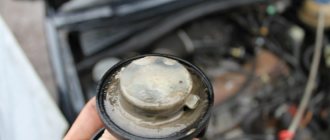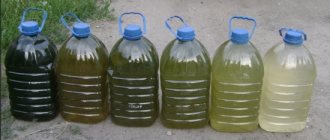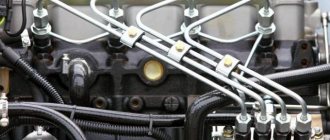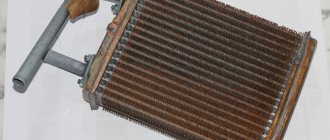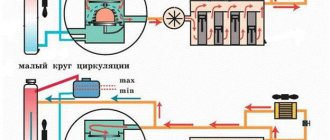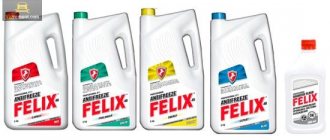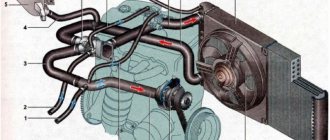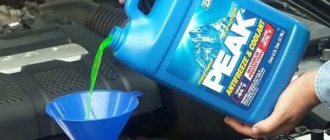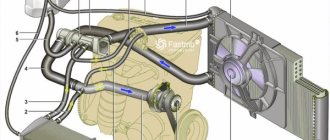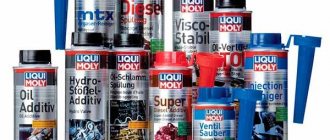An important component of the internal combustion engine is the cooling system, which is filled with antifreeze, antifreeze, or water (mostly domestic trucks are filled with water in the North, so they do not turn off the engines throughout the cold period of winter).
- using Coca-Cola;
- using special auto chemicals;
Flushing the engine cooling system.
Antifreezes generally have a service life of 5 years or until the engine travels 250 thousand km. Antifreeze has a service life of 2-3 years. By the way, you can see what happens if you mix antifreeze with antifreeze. Depending on the operation of the vehicle and the quality of the coolant, if the coolant is not changed or if the coolant is diluted, the radiator channels and cooling jacket become clogged. Therefore, to increase the overhaul life of the engine, it is necessary to periodically flush the engine cooling system. You can wash it both in car services and at home in your own garage.
Many drivers clean the cooling system with their own hands. Some use citric acid, some use Coca-Cola, some use diesel fuel, some use special equipment (eg Laurel), some use something else.
Anyone who wants to avoid problems with the engine must flush the cooling system regularly at certain intervals. During engine operation, deposits, rust, oil deposits, sediment and scale accumulate on the walls of the radiator and pipes. There will be much more clogging substances if the engine was running at high speed, the temperature almost reached the red mark.
If the radiator channels and pipes are clogged, then circulation will deteriorate accordingly. And poor engine circulation will create additional problems: the engine will overheat (which may cause the cylinder head to be removed to replace the gasket), cool air will blow from the stove, and engine parts are subject to increased wear.
It is advisable to flush the car's cooling system once a year. To change the coolant you need warm weather.
There is a cooling radiator icon on the instrument panel, which, if lit, indicates either a low level of antifreeze or antifreeze, or that the radiator needs to be cleaned or replaced. This icon is found on some car brands.
A list of cars, how many liters of antifreeze in the cooling system we looked at in another article. It shows the brands and models of cars and the required coolant volumes for them.
Causes of clogging
The main reason for a clogged cooling system is water getting into the engine. The composition of the water additionally includes various salts and microelements, which, when it evaporates, remain on the walls of the engine, which leads to the appearance of scale. This problem can be partially solved by using distilled water, but this is not enough, since another big problem is dust, which also gets into the engine.
Usually the problem of clogging is solved by pouring antifreeze or antifreeze. In theory, these fluids should prevent scale formation and slow down corrosion. However, in practice, these liquids act only for a limited amount of time, since the protective additives included in their composition quickly lose their protective properties. Also, in some cases, antifreeze and antifreeze may partially decompose into their constituent components, which can also settle as scale, which further complicates engine operation.
The quality of antifreeze directly determines the engine’s ability to withstand overheating.
Signs that it's time to clean your cooling system.
If one of the following signs is detected, then it is imperative to clean the engine cooling system:
- The engine temperature rises sharply, and this happens often.
- When the engine is at operating temperature, cold air blows from the heater.
- The pump is not working well.
- The fan turns on early and runs at high speeds.
If such signs and causes appear, you need to study the flushing scheme, how to flush, what to flush with, and how to correctly fill in new coolant.
Rules for draining old antifreeze
You need to learn a few rules for filling and draining coolant.
- Antifreeze is added and drained only after the engine has completely cooled down.
- Before washing, check the cap of the expansion tank. It must be open.
- Safety rules must be followed. Since additives are caustic chemicals, work with them only with rubber gloves to avoid damaging the skin of your hands.
What means are not advisable to flush the engine cooling system?
Coca Cola
Many people know that Coca-Cola can be used to remove scale and clean radiators.
There are many videos on the Internet on using Coca-Cola to clean teapots and other items in which deposits form. Coca-Cola can be used to flush radiators and all channels of the engine cooling system. Coca-Cola contains phosphoric acid, which perfectly removes rust, greasy deposits of oil and additives. But there is one thing. The fact is that in addition to orthophosphorus acid, Coca-Cola contains sugar and a lot of carbon dioxide.
If you chose the Coca-Cola method of flushing the cooling system, then:
- We need to release carbon dioxide from it.
- Drain the old fluid.
- Pour cola.
- Wait no more than 10 minutes, as it corrodes plastic and rubber products and the surfaces of aluminum parts.
- Drain the cola.
- Rinse several times with clean water to ensure no sugar remains in the system. When adding antifreeze, the remaining droplets of sugar may react and the properties of the antifreeze will change.
Fairy
Some may use this chemical to flush the internal combustion engine refrigeration system, but it’s not worth it. It removes grease perfectly, but does not dissolve rust and other deposits. But with the help of fairies you can perfectly wash the outside of the radiator. During the summer, many flies and other insects stick to the front of the radiator.
Calgon
Products such as calgon and others (Mr. Muscle, Tiret), similar to them, are used to protect against scale formation. It is unlikely to be able to remove rust and deposits. It is better to add it to the washing machine so that scale does not settle on the drum.
White
A powerful product for removing dirt, germs, mold with a pungent, persistent odor. White contains sodium hydrochloride, which can corrode the surfaces of aluminum parts. When heated, the white will quickly corrode aluminum tubes. Therefore, you should not use or experience it yourself.
Mole
Mole cleaning agent can only be used in copper main radiators and stove radiators, because it contains caustic soda. It will ruin aluminum surfaces. It also corrodes rubber seals and seals.
After flushing, you also need to be able to fill in new coolant, otherwise an air lock may form. Then you will have to expel this air lock from the system.
Combined method of citric acid, vinegar and soda
There are those who mix various substances in the hope of getting a super solution for flushing the engine cooling system.
Make the following mixture:
- 50% soda;
- 25% citric acid;
- 25% vinegar.
Such homemade chemical mixtures may clean the channels in the system, but at the same time they will destroy the rubber seals.
Recommendations from antifreeze manufacturers
Each coolant manufacturer indicates its service life on the packaging. After this period, it is best to replace the antifreeze.
The replacement interval depends on what kind of fluid is used in the system. Let's look at the example of the main classes of antifreeze: G11, G12 and G13.
Class G11 coolants include antifreezes based on inorganic additives. They form a protective layer on the internal surfaces of the system that protects against corrosion. If such fluid is not replaced in time, this layer will begin to precipitate and clog the system. It is recommended to change such antifreezes every 2 years.
G12 class coolants use organic acid technology. They do not form a protective layer over the entire internal surface of the system, but only localize emerging pockets of corrosion, preventing their further spread. The recommended service interval for replacing such fluids is 5 years. This also applies to G12+ and G12++ antifreezes.
The last class of coolants is G13. They are made on the basis of safer propylene glycol, in contrast to G11 and G12 antifreezes, where the main substance is toxic ethylene glycol. The service life of such liquids ranges from 5 to 10 years, and some manufacturers even claim that their antifreeze is poured for the entire service life of the cooling system.
But you shouldn’t focus on the time interval, because each car can travel a different number of kilometers during this time. Therefore, manufacturers additionally indicate on the packaging how many thousand kilometers a particular liquid can be used for.
Special liquids for flushing the cooling system
Those who are not going to try drinks, descalers, as well as folk remedies as a cleaner and do not trust them, they choose auto chemical products.
Manufacturers of auto chemicals are constantly developing new products, so there is a wide range of choice.
Classification of liquids by chemical composition:
- Neutral. Neutral are those with pH = 7. You can buy a ph meter and check what kind of water we drink (it’s good to drink alkaline water), etc. Neutral liquids do not have various alkaline and acidic impurities. Such liquids by themselves cannot clean the cooling system channels well.
- Acidic. Such liquids have a pH <7. Well used for purifying organic substances.
- Alkaline. Alkaline ones have a pH>7. Effectively dissolves organic contaminants.
- Two-component. Such liquids contain both acidic and alkaline elements. Effectively dissolve and remove scale, rust, and various deposits resulting from the breakdown of antifreeze or antifreeze.
It is advisable to use only one liquid based on its chemical composition. Not so, first alkaline, then acidic, or vice versa.
Among the TOP auto chemical products for flushing the engine cooling system are the following:
- Lavr Radiator Flush Classic (Lavr Radiator Flush Classic) is a chemical product from Russian manufacturers. Effectively used for complete cleaning of the internal combustion engine cooling system. The cost of a half-liter container of Lavra is about 300 rubles.
How to use LAUREL:
- Drain the coolant.
- Pour in two-component LAUREL. Volume 430 ml is enough.
- We fill the system with water after Laurel.
- We start the engine and let it idle for 30 minutes.
- Shut off and drain the fluid.
- Fill with distilled water for rinsing.
- Start the engine and let it idle for 15 minutes.
- Drain this liquid and add new antifreeze or antifreeze.
After such cleaning, deposits of scale, rust and dirt will be removed from the system. The pump and antifreeze will last longer.
2. LIQUI MOLY Kuhler-Reiniger (Liqui Moly Kahler-Reiniger) - a product from a German manufacturer of chemicals for cars. The cost is around 500 rubles for a 300 ml can. There are no aggressive substances in the composition.
If you need to flush the radiator channels and the system as a whole from rust and oil deposits, then Liqui is perfect for this. Does not destroy rubber and plastic products.
To prepare flushing fluid for a car’s cooling system, one 300 ml bottle is enough.
How to use LIQUI MOLY:
- Drain some of the old fluid from the system.
- Pour the entire contents of the can directly into the radiator.
- Start the engine and let it idle for 30 minutes or you can also drive it.
- Drain the liquid. What usually comes out is a dirty brown liquid.
- Rinse with distilled or boiled water.
- Fill with new antifreeze or antifreeze.
3. Hi-Gear Radiator Flush-7 minute - a product from American manufacturers. The price of a 325 ml vessel is about 6 dollars. Used in different countries to clean the cooling system of cars and trucks. The working time declared by the manufacturer is 7 minutes. There is also a 5-minute action.
After using High Gear Radiator Flush 7, the efficiency of the radiator increases by 1.5 times, fluid circulation in the system is restored, and it does not corrode the seal of the pump and other rubber-plastic products.
How to wash the outside of a car radiator
The cooling radiator is actively used. During operation, it becomes clogged with dirt and debris. Then the heat does not completely escape into the environment, but flows back to the engine. As a result, the motor overheats. The radiator must be cleaned regularly to keep the vehicle in good working order. To clean the outside of the unit, you can use ordinary water. If there is persistent contamination, then water alone will not be enough. Then it is better to take a special substance to clean the outside of the car radiator. There are many universal products on sale that are good at cleaning dirt from the unit. The cost of such substances varies. It depends on the composition and manufacturer.
Auto chemicals contain concentrated components that quickly remove salt deposits, rust, oil stains, and dirt. For external cleaning you will need buckets, brushes, work gloves, rags, and cleaning agent. To wash the outside of the radiator, you must first remove it from under the hood. You can perform the procedure using soapy water and a brush. This is the easiest way to clean the radiator externally. After soaping the knot, it is washed with warm water.
How to flush a cooling radiator
Manufacturers produce effective products for flushing the radiator from the outside. The following substances have good reviews:
- Liqui Moly Kuhler Reiniger. An excellent product for removing scale, dirt with grease particles and chemical compounds.
- Hi-Gear. Designed for old dirt and rust.
- Mannol - External cleaning of the unit removes rust, scale and other deposits.
If external cleaning does not bring results, you will need to perform internal flushing. If there is serious damage, the unit will need to be replaced. In many cases, mechanical cleansing is successfully carried out independently. This solves the problem of overheating. At the same time, they inspect the pipes and hoses, change the radiator cap and thermostat.
Choice of drug
Before purchasing a flushing agent, you need to determine the predominant nature of the coolant contamination. When inorganic components predominate (scale, products of corrosion and oxidation of metals), a white precipitate with a hint of rust is observed under the cap of the radiator tank or conservator. For this case, choose an acid-containing cleaner based on orthophosphoric acid or its phosphates.
Organic contaminants (antifreeze decomposition products, oil, dirt) give the antifreeze a cloudy color. To remove them, you must use an alkaline detergent. Along with the main elements: surfactants, pH acid-base balance regulator, the preparation must contain complexing additives that promote intensive dissolution and removal of dirt residues.
It is good when the composition contains anti-corrosion inhibitors that protect parts made of metal. Finally, for water-based washes, deionized water should be used and the packaging should indicate this. Regular water contains salts that cause limescale formations.
Tip: when choosing a specific product for flushing the cooling system, consider the condition of the radiator, other devices and the fluid to be replaced.
